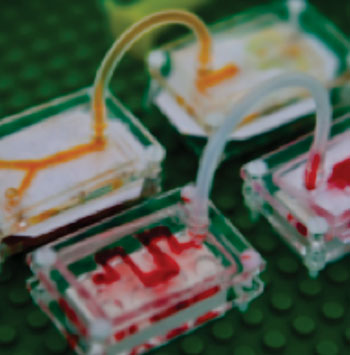Rapid Lateral Flow Assay Detects Several Viral Fevers Simultaneously
By LabMedica International staff writers
Posted on 11 Mar 2015
A team of biomedical engineers has developed a rapid diagnostic test that is able to detect several viruses such as Ebola, dengue fever, and yellow fever simultaneously from a single sample of patient's serum.Posted on 11 Mar 2015
Investigators at the Massachusetts Institute of Technology (Cambridge, MA, USA) and Harvard Medical School (Boston, MA, USA) used a novel class of silver nanoparticles to drive a paper-based lateral flow assay. Lateral flow assays are commonly used to detect such pathogens as Rotavirus, adenovirus, Streptococcus A and B, and gonorrhea and in rapid pregnancy tests.

Image: The diagnostic system is based on triangular silver nanoparticles that display different colors depending on their size (Photo courtesy of the Massachusetts Institute of Technology).
The investigators extended the usefulness of the lateral flow approach by incorporating antibodies bound to different colored nanoparticles. In the current version of the assay, following a 10 minute incubation, an orange band indicates the presence of yellow fever virus, a red band indicates Ebolavirus, and a green band indicates dengue fever virus.
The investigators expect that their new rapid test will complement more definitive diagnostic technologies, such as PCR. "If you are in a situation in the field with no power and no special technologies, if you want to know if a patient has Ebola, this test can tell you very quickly that you might not want to put that patient in a waiting room with other people who might not be infected," said senior author Dr. Lee Gehrke, professor of microbiology and immunology at Harvard Medical School. "That initial triage can be very important from a public health standpoint, and there could be a follow-up test later with PCR or something to confirm."
This type of diagnostic testing device is readily customizable to detect other infectious diseases, by linking the silver nanoparticles to different antibodies. "Thankfully the Ebola outbreak is dying off, which is a good thing, but what we are thinking about is what is coming next," said Dr. Gehrke. "There will undoubtedly be other viral outbreaks. It might be Sudan virus, or it might be another hemorrhagic fever. What we are trying to do is develop the antibodies needed to be ready for the next outbreak that is going to happen."
The rapid diagnostic test for multiple viral fevers was described in the February 12, 2015, online edition of the journal Lab on a Chip.
Related Links:
Massachusetts Institute of Technology
Harvard Medical School













